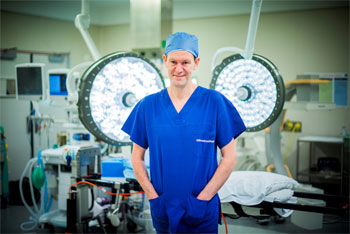Avoid Spine Injury When Exercising

Avoid Spine Injury When Exercising
Exercise and sports – what's best for your back and spine & how to avoid injury by Sydney neurosurgeon Dr Richard Parkinson
When it comes to health and fitness, there are many options from traditional gyms, to circuit based training, fitness camps, team sports and now many new fitness apps. Most people are excited to give them a go, with a tall list of health goals at the front of mind, however one thing they don't anticipate is their health taking a tumble. As a doctor, I'm regularly faced with many exercise and sports related injuries, and a lot of the times it's the smallest range of movement, often after squats or dead lifts that can result in injury to the back and spine.
Most common injuries people sustain:
Acute disc injuries – including disc herniation and disc tears – these refer to an injury to one of the discs between the individual bones (vertebrae) that make up your spine.
Back ligament injuries – when ligaments are stretched too far or torn.
Strain injuries – tears to muscle fibres as a result of over-use.
How do these injuries usually occur:
The majority of acute disc injuries occur from lifting heavy weights, even within a very small range of movement. I often see injuries after squats and dead lifts. It's due to an axial compression on the disc"in other words, compression from top to bottom.
Top tips to lifting correctly:
Don't be macho about lifting weights"get as much help as you can, particularly if you're lifting more than 10 to 15 kilograms.
Lift correctly - Try to keep the weight as close to your centre of gravity as you can, rather than reaching out.
No twisting – Don't twist your body at the waist while lifting. Avoid forcible bending, twisting or pulling as much as you can while lifting heavy weights.
Use aids - Make use of any lifting aids that are available to you. They're there for a reason.
Don't take on heavy weights all at once - The typical recipe for disaster is the person who has suddenly decided they're on a health kick and starts lifting heavy weights that they're not appropriately trained for. Lifting big weights straight off the bat is asking for trouble
Supervision - Any lifting of heavy weights requires careful supervision, the building of core muscles and appropriate, graduated training to ensure safe technique.
Avoid back-breaking injuries:
Research supports the fact that having strong back muscles that can splint and supplement your back is a way to improve its resilience. If you take a human spine, and you strip it of all muscles, it will fail at a weight of about five kilos. If you place the muscles that splint the back"the back muscles, the front muscles, and the abdominal muscles"the ability of the spine to bear weight is multiplied.
To strengthen your mid and upper back and avoid common gym injuries, attempt reverse shrugs, which are done by pulling your shoulder blades a few inches forward while doing straight-arm pull-downs. To strengthen your upper back, sit against a wall and tilt your pelvis under, so there are no gaps between your back and the wall. Then, straighten your arms in front of you and attempt to raise them to your ears, all the while keeping your lower back flat onto the wall. I would also recommend standing as you exercise as much as possible.
What are some of the best sports for your back/spine:
Swimming - this is by far the best form of exercise if you are wanting to protect your back and your spine, with the buoyancy of the water taking out all the stress and impact on your joints, while also strengthening back and core muscles.
Cycling – a good aerobic option as there is minimal twisting involved and jarring to the back and spine.
Low intensity running
Any high impact sports, such as tennis, squash, golf (because of the twisting), as well as full contact sports such as rugby and wrestling/fighting are amongst the most problematic for the back and spine.
Dr Parkinson is a highly trained neurosurgeon who has performed ground breaking and complex surgery on some of Australia's elite sportspeople and recognised as a leading expert in sports injuries. Dr Parkinson has attained internationally esteemed qualifications from both the USA and Australia and is a highly respected specialist at the forefront of neurosurgical science and development.
Dr Parkinson was the first to be trained in neurointervention in Australia and his expertise in the diagnosis and treatment of sports and neurological injuries is highly sought after by elite sportspeople throughout Australia.
Dr Parkinson is also involved in the rehabilitation of NRL and ARU players who have suffered brain and spinal injuries. He regularly contributes to medical publications, and consults major sporting bodies as an authority on spinal and neural conditions. He offers unequalled expertise on their prevention, diagnosis, treatment and rehabilitation.
MORE



